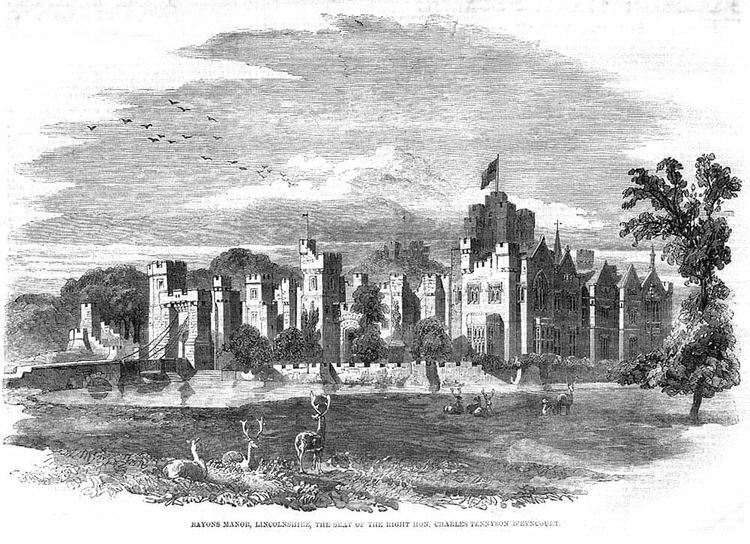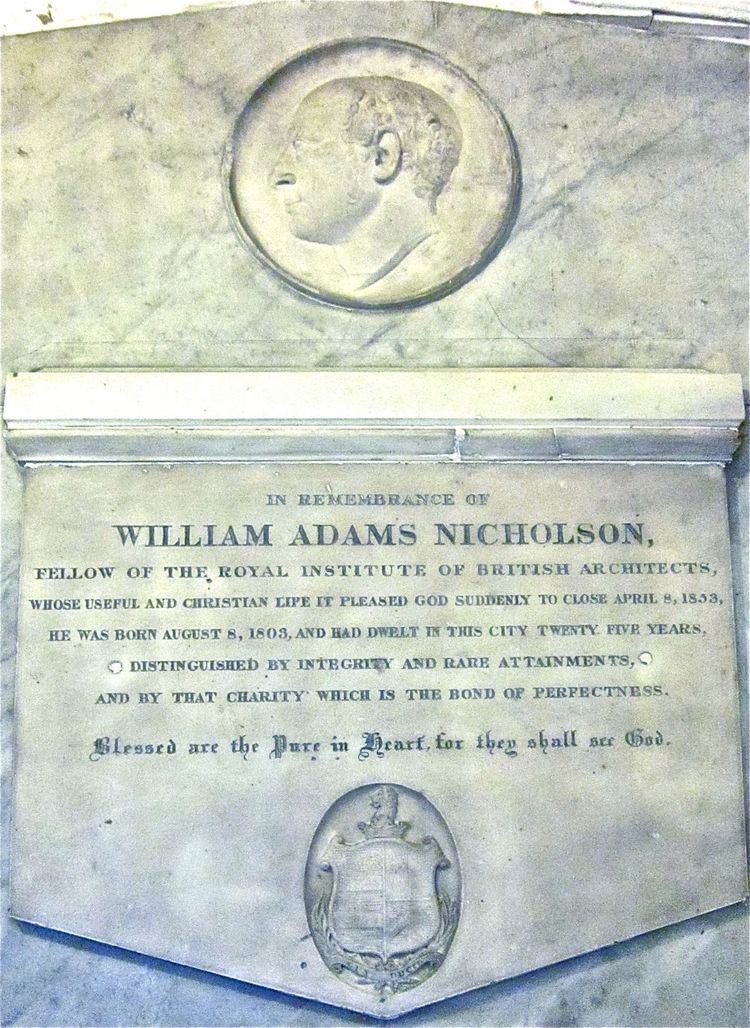Born on 8 August 1803 at Southwell, Nottinghamshire, he was the son of James Nicholson, carpenter and joiner. James gave up his business about 1838 and became sub-agent to Sir Richard Sutton's estates in Nottinghamshire and Norfolk. William was articled about July 1821, for three years, to John Buonarotti Papworth, architect, of London. By 1824 Nicholson had returned to Southwell where he was to work with the Rev J. T.Becher on the design of the Southwell Workhouse. In 1828 he established himself at Lincoln; and there and in the neighbouring counties he built up an extensive practice. From 1839 to 1846 he was in partnership as Nicholson & Goddard, with Henry Goddard (1813–1899). Charles Baily was a pupil. Another pupil of Nicholson's was Michael Drury. His assistant John Spence Hardy and his pupil Pearson Bellamy set up the practice of Bellamy and Hardy in Lincoln after his death.
Nicholson joined the Royal Institute of British Architects as a founding fellow at its commencement. He was a member of the Lincolnshire Literary Society, and of the Lincolnshire Topographical Society. He was in attendance at Boston as a professional witness when he was suddenly taken ill, and died there on 8 April 1853. He was buried at Lincoln, in the churchyard of St. Swithin, in the parish where he had resided for many years.
In 1824 Nicholson married Leonora, the youngest daughter of William Say of Norton Street, London. His second wife, Anne Tallant, survived him.
Possibly Nicholson's most important contribution was in the design of Workhouses. His pioneering Southwell Workhouse (1824) was important forerunner of the radially planned workhouses of the New Poor Law. Nicholson was to go on to design workhouses at Glanford Brigg in 1836 and at Lincoln in 1837-8 -both of which have now been demolished.
Southwell WorkhouseGlanford-Brigg WorkhouseLincoln Workhouse. Lincoln Union Workhouse was erected between 1837 and 1838.As well as working in the Gothic revival style of architecture, Nicholson could also work very effectively in classical styles. He designed the Mansfield Town Hall in a Grecian style portico with Doric columns. More striking is the Corn Exchange of 1847 in the Cornhill Lincoln. Here he has a projecting portico with Corinthian columns at Piano nobile level. Nicholson also appears to have been responsible around 1844, for the extension of the Lincoln Stonebow frontage, facing Saltergate. This he handles in a very convincing Tudor Gothic Revival style.
Mansfield Town Hall. 1836. In a heavy neo-classical style with a four column Tuscan porch.The Nottingham Dispensary, No 12. Broad Street, Nottingham. 1841-3. Classical rendered front with full-height ionic pilasters above a rusticated ground floor.Mayor's Parlour added the Stonebow, Lincoln.. After 1840 Nicholson appears to have made extensive alterations to the east end of the Stonebow, when the building that had housed the old City prison was pulled down. The present building to the east of the Stonebow, completed about 1844, now contains the Mayor's ParlourThe County Prison in Lincoln Castle. In 1847-8 the prison was enlarged following plans by Nicholson and Goddard. A new range was built parallel to the original building of 1787 and linked to it with a corridor. The new range in was sparsely detailed but with two massive lateral chimney stacks. At the east end of this range was the prison chapel. As the prison operated the silent system there were separate cubicles for each prisoner and were arranged so that prisoners could see the preacher, but not each other.St. Mark's Station, High Street, Lincoln. It has been suggested that Nicholson was the architect for St Mark's station in Lincoln High Street of 1846 - the centre with a massive Ionic portico and fluted columns and the side pavilions with Doric pilasters. However, this attribution lacks definite documentation. A surviving drawing of the facade station of the station is signed I.A. Davies. This could well be the London architect John Davies (1796-1865) who worked in the Grecian revival style.Worsbough Hall, Barnsley, South Yorkshire. Extended and altered for W. B. Martinin Elizabethan style with a centre and two wings. It was let to a local colliery owner then bought by the National Coal board and used as offices.When they moved out in the early 1960s it was left empty and decaying. It is now being converted modern luxury apartments.Bayons Manor, Tealby, Lincolnshire. Built between 1836 and 1842 for Charles Tennyson D'eyncourt, to designs by William Nicholson and with contributions made by Anthony Salvin. It consisted of castellated mansion with a moat, machicolated and embattled towers, curtain-wall and great hall with a hammer-beam roof. It was situated on rising ground to provide a picturesque scene and to give the widest views. The house was occupied by troops during the Second World War, and was sold in 1944. After many years of neglect it was blown up in 1964.Brattleby Hall, Lincolnshire. Small country house of c1780, remodelled for Edward Wright in 1838-9 by William Nicholson, with additions of 1875-80. Three storeyed house which is cement or stucco faced.Three bay front with quoins. Central doorway with paired, partially glazed doors flanked by paired ionic pilasters.South Elkington Hall near Louth. c.1841. A mansion in Italianate style with a tower. Now partiality demolishedOxcombe House. In the style of Nicholson. Built in 1845. Tudoresque, with mullioned and transomed windows. Buttresses crowned by turrets on either side of the porch.The Vicarage, Brigg Road, Hibaldstow, Lincolnshire. 1851-52 by Williams Adams Nicholson. Red brick with stucco details, Welsh slate roof. Internal entrance porch with surround of square columns supporting plain entablature and hood; half-glazed door in reveal with margin lights above 2 panels.Church Building and Restoration
Wragby, All Saints. 1839. Yellow brick in the style of a Commissioners' church. The detailing on the tower is very similar to that used by Nicholson on Brigg church.Scawby 1840-2. North Lincolnshire. The church of St Hybald is dedicated to a 7th-century Saxon The tower is The tower is original, of the 15th century, with 13th-century work at the base, but the remainder of the church was substantially rebuilt in 1840-2 by Nicholson, and in 1870 by James Fowler of Louth.Glandford-Brigg St.John the Evangelist's church By W.A.Nicholson 1842-3Kirmond le Mire, Lincolnshire. Built in 1847St Peter at Gowts church, Lincoln, The north aisle and porch were built in 1852 to designs by Nicholson.This group of churches, in the vicinity of Louth, present a problem. They have similar design characteristics, and while they appear to be by the same architect they have been attributed to either Nicholson or to the Louth architect G. R. Willoughby. Little is known about Willoughby, although he was still working in 1868 It may be that Willoughby was the supervising architect for these churches and Nicholson had supplied the plans. Leech has argued that the main design input may have come from Willoughby as they are distinct from the other churches built by Nicholson It should be noted that Nicholson worked extensively for the Chaplin family of Blankney, so it might well be expected that he was the architect selected when the Rev Henry Chaplin paid for the new churches at Haugham and Raithby. Antram has described these churches as being pre-archaeological and gimmicky, yet many of the features described such as the crockets appear to be closely copied from the limestone churches in the Grantham area and the flying buttresses used to supported the crocheted spires as at Haugham, are similar to those on Louth church. Typically this group of churches have been built of brick, but cement or stucco rendered to give the impression of ashlar masonry. Documentary research may resolve the problem as to who was the architect of these churches.
Raithby by Louth Rebuilt in 1836-7 in the florid Gothic style, mainly at the expense of the patron (Charles Chaplin) and the Rector .Haugham, nr. Louth, Lincolnshire. !840-1. Brick, spire supported by flying buttresses. By G R Willoughby, but presumably in association with Nicholson. The church was cement rendered to give the impression that it was built of stone.Oxcombe, All Saints Church. Built in 1842 and attributed to the architect William Adams Nicholson. A small church, built in brick with an octagonal west tower, which also forms the porch to the church It has a two bay nave with a chancel with a three sided apse. The bell stage of the tower is an open stone lantern with cast-iron pinnacles. The church was declared redundant in 1980 and is in the care of the Lincolnshire Old Churches Trust.BiscathorpeThe Big Wesley at the junction of Clasketgate and Danesgate in Lincoln. Wesleyian Chapel of 1837, built for1400 persons. Demolished in the 1960s. Built in Neo-classical styleSt Peter in Eastgate Primary School, Eastgate, Lincoln. 1851. Pevsner described this as a Tudoresque villagey school. A further school was built on this site by William Watkins in 1881 which was later combined with the earlier school.The village of Blankney, near Lincoln, was almost rebuilt for Charles Chaplin. The village was laid out by Nicholson in the 1830s and 1840s and later housing may have been added by William Watkins (architect) in 1876. Nicholson's work can be recognised by the ‘‘shaped’’ gables and the tall chimney stacks. The village school is described as being a neat building in Elizabethan style.Leadenham Nicholson put up farm buildings on the estates of General Reeve of Leadenham HouseStamford. Nicholson undertook work Sir John Wyldbore Smith, bart. of Blandford in Dorset who held land in Stamford.Work on the estates of C. Turnor, of Stoke Rocheford which included church and farmhouse additions and alterations were at Great Ponton, Panton, Lissington, Langworth, East Torrington, East Barkwith, Wragby, Binbrook and Kirmond le Mire.Grange Farm, Little Ponton-built for Christopher Turnor.Antram N (revised), Pevsner N & Harris J, (1989), The Buildings of England: Lincolnshire, Yale University Press.Antonia Brodie (ed), Directory of British Architects, 1834–1914: 2 Vols, British Architectural Library, Royal Institute of British Architects, 2001, Vol 2, pg264 and pg 565.Colvin H. A (1995), Biographical Dictionary of British Architects 1600-1840. Yale University Press, 3rd edition London, pg.1140.Morrison K. (1999), The Workhouse: A Study of Poor-Law Buildings in England, English Heritage/RCHME, ISBN 9781873592366Obituary in the Builder, Vol.11, 23rd Apr 1853, pg.262.

